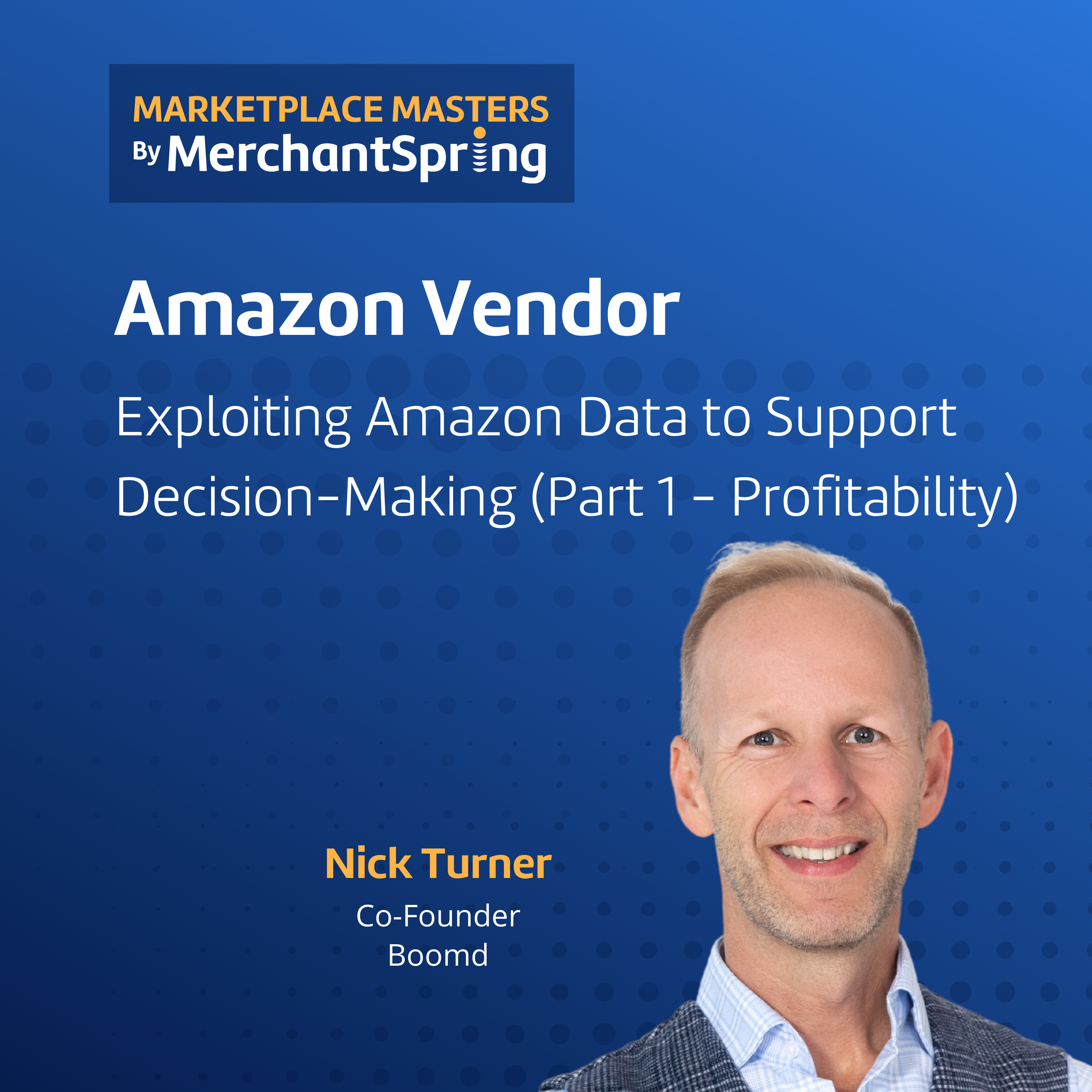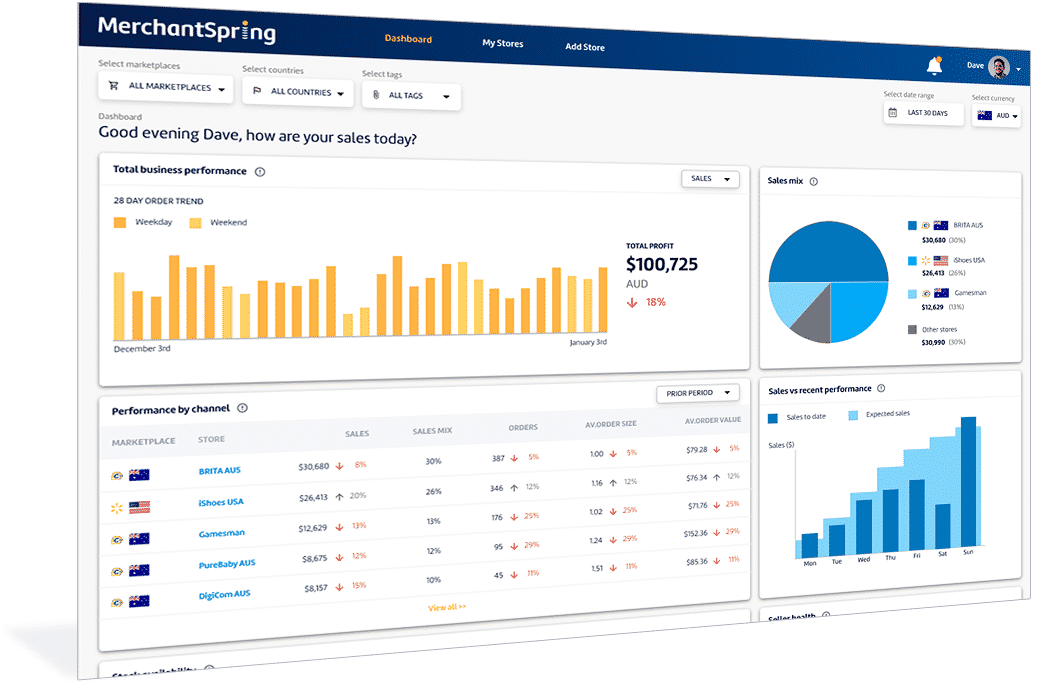Navigating the Complexities of Vendor Profitability
Overview
In this episode, Nick Turner of Boomd joined Paul Sonneveld and explored how you can exploit Amazon Vendor data to support your decision-making.
Exploiting Amazon Vendor data
In this podcast episode, the host and guest speaker discuss how to exploit Amazon vendor data to support decision-making, with a specific focus on vendor profitability. The guest, Nick Turner, co-founder of Amazon agency Boomd, brings his expertise to the conversation. They emphasize the lack of resources available for vendors to understand profitability on the platform and the importance of addressing this gap.
“If summarize the three areas the first is Cost of Goods and the Distribution…
Moving on to the Amazon terms… And then marketing…” -Nick Turner, Co-Founder, Boomd
The discussion is divided into three main areas: cost of goods and distribution, Amazon terms, and marketing. Nick explains that understanding the costs associated with each SKU is crucial for vendors, especially considering the evolving nature of the industry due to factors like currency fluctuations and supply chain disruptions. They also highlight the need to carefully review the terms outlined in the vendor's contract with Amazon to accurately assess profitability.
The conversation then shifts to marketing, which is identified as a potential stumbling block for vendors. They stress the importance of considering how marketing costs relate to the cost price and overall profitability. Throughout the discussion, the complexity and depth of the topic are acknowledged, with the host and guest aiming to provide a concise overview within the podcast's time constraints.
Understanding costs for Amazon partnership

Understanding the costs associated with partnering with Amazon is crucial for vendors looking to maximize profitability. The podcast transcript highlights various factors that need to be considered when developing a cost price to present to Amazon. These factors include distribution costs, heavy energy costs, storage costs, and the preparation of items.
Distribution costs and heavy energy costs have a significant impact on every aspect of the supply chain, making it essential to account for them when calculating the cost price. Additionally, certain products may require specific storage conditions, such as humidity or temperature control, which can further increase storage costs.
The preparation of items before they reach an Amazon Fulfillment Center is another crucial aspect to consider. Certain products need to be packaged in specific ways, and having a reliable distribution partner is essential to ensure timely delivery to the right location.
The podcast transcript also emphasizes the importance of understanding the terms agreed upon with Amazon. These terms can include dedicated support, freight and damage allowances, and co-op activities. It is critical to review the contract and fully comprehend each term to avoid any unexpected costs.
Understanding Amazon's chargebacks is crucial
Understanding Amazon's chargebacks is crucial for vendors looking to maximize profitability. Chargebacks are costs that vendors may incur if they fail to meet certain obligations or make mistakes in their partnership with Amazon. These chargebacks can significantly impact a vendor's profitability if they are not properly understood and accounted for.
One area where chargebacks can occur is in the distribution process. Vendors need to accurately forecast demand and ensure they have enough stock to fulfill orders. If they accept orders without having enough stock, they may have to backtrack on the order, resulting in chargebacks and penalties from Amazon.
“So it is critical that vendors understand everything about the you know, how that preparation should be done and how things should be delivered and why they you know why things have to be done on time. That's the reason and then so we go through Logistics and transportation, things can go wrong there and then on to the receiving side, when Amazon gets the items and checks them.” -Nick Turner, Co-Founder, Boomd
Another area where chargebacks can arise is in the preparation of products for shipment. Amazon expects products to be prepared properly, and any mistakes or issues in this process can lead to additional costs. Vendors need to understand and adhere to Amazon's preparation requirements to avoid chargebacks.
Logistics and transportation can also be a source of chargebacks. Any issues or delays in the transportation of products to Amazon's warehouses can result in additional costs. Vendors should have reliable transportation partners and processes in place to minimize the risk of chargebacks in this area.
Marketing is critical for vendors
Marketing is critical for vendors, especially when it comes to selling products on Amazon. In the podcast transcript, the hosts emphasize the importance of creating demand and driving sales. They compare the flow of products through Amazon to a pipe, stating that if there is not enough demand and customers buying, the pipe will fill up and orders will dry up.
“So it is absolutely critical for vendors to pay a lot of attention to everything to do with marketing. That's advertising. We put some ideas here deals, lightning hero deals and so on. Vouchers, price promotions and you expected to fund these and is in your interest to get the products moving. The products moving means they improve in organic ranking, it means they hopefully get good reviews and it's a virtuous circle.” -Nick Turner, Co-Founder, Boomd
Vendors are responsible for helping to create the demand for their products. This involves various marketing strategies such as advertising, deals, lightning hero deals, vouchers, and price promotions. These marketing efforts are essential for getting products moving and improving their organic ranking on Amazon. Positive reviews and increased sales contribute to a virtuous circle where advertising performance improves, leading to more purchase orders for successful products.
However, it is not enough for vendors to simply engage in marketing activities. They must also measure and analyze the costs associated with these efforts. The hosts stress the importance of understanding all the costs and even breaking them down to SKU levels. This level of analysis allows vendors to see the attributable costs for each category and make informed decisions about their marketing strategies.
The podcast also mentions that marketing packages on Amazon may be unique to the vendor-seller relationship. These packages offer various advertising options, including big branded headlines and audience targeting. Vendors have the opportunity to purchase these packages and work with experts to optimize their advertising spend and achieve good results.
Understanding the cost of selling on Amazon

Understanding the cost of selling on Amazon is crucial for vendors who want to maximize their profitability and success on the platform. In a podcast episode, the hosts discuss the three main areas of cost that vendors need to consider: the cost of goods, potential chargebacks, and marketing expenses.
The cost of goods is not a fixed amount and can vary over time. Vendors need to regularly reassess their cost prices with Amazon to ensure they are making a profit. Chargebacks, which are fees incurred for various reasons such as returns or customer complaints, are also an important consideration. Vendors can address chargebacks by challenging them and implementing processes to minimize their occurrence.
Marketing is highlighted as a critical component for vendors to generate momentum and increase purchase orders on Amazon. By investing in marketing efforts and measuring their effectiveness, vendors can drive sales and succeed on the platform.
In conclusion, the podcast emphasizes the need for vendors to understand and manage the costs associated with selling on Amazon. By carefully analyzing the cost of goods, chargebacks, and marketing expenses, vendors can increase their profitability and thrive on Amazon.















Add a Comment